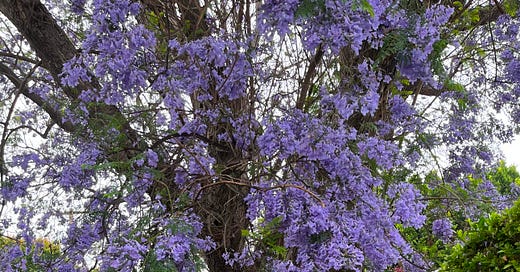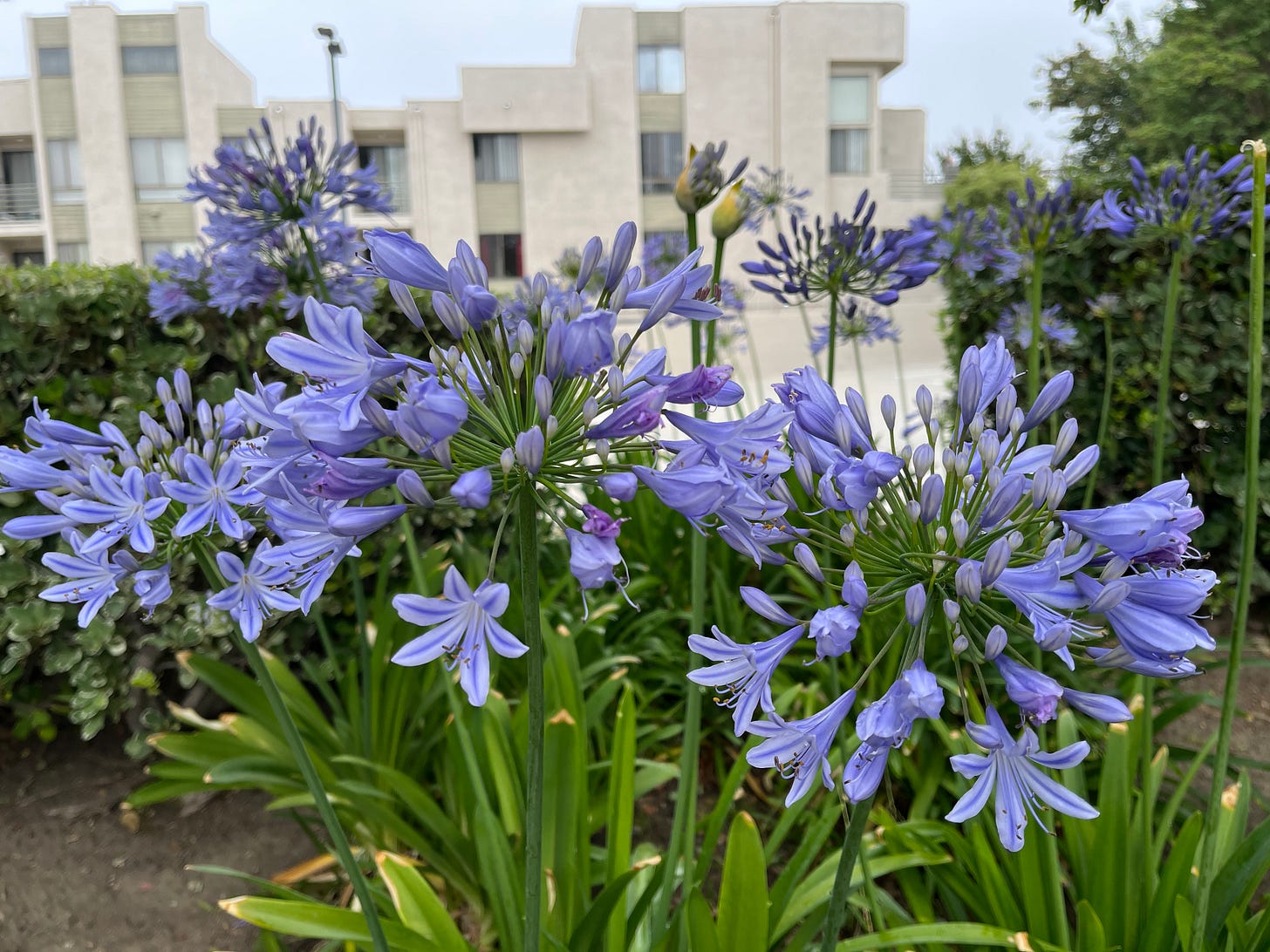Transplants to Los Angeles often comment that they “miss the seasons,” because the leaves don’t change in the autumn, but if you spend a few years here you’ll start to notice very distinct cyclical patterns. Bright sunny summers are swept away by the hot desert winds of the fall, bringing skies full of dust and smoke that are only cleared by the rains that arrive around New Year’s Day. In the winter the city is surrounded by snow-capped peaks, and when the snow melts everything turns green, the hillsides flush with blooms of invasive mustard weed that dry into straw under the gray skies of May. And then, in the gloom of June, right before schools let out and summer begins, the city explodes with the purple blossoms of Jacaranda trees.
Like many things about Los Angeles, Jacaranda Season is contrived. Jacarandas are native to Argentina and Brazil, and were brought to California by the American settlers who began to flood the area in the second half of the nineteenth century. Horticulturist Kate Sessions is credited for promoting the Jacaranda after she discovered that it thrived in her experimental nursery, which later grew into San Diego’s Balboa Park. The Jacaranda trees we now see all over LA were planted starting in the 1910s and 20s, as the population of the city expanded. Adding to the annual show the Jacarandas put on are the agapanthus flowers, native to South Africa, which spring from the ground and explode from their long stems like fireworks. It is purely a coincidence that these same-colored non-native flowers bloom at the same moment in Los Angeles every year, but they do, like clockwork, a celebratory end to the academic calendar, and also coincidentally, my birthday.
I was never one to pay much attention to flowers as a young person, so I didn’t really notice the timing of these blooms until a visit from my husband’s aunt Ciba, in 2011. Ciba flew from North Carolina to stay with us and meet the babies—our seventeen-month-old son, and a daughter who had just been born. Ciba was a writer and editor who had worked for Better Homes and Gardens and Victoria, and she knew the names of all the flowers in our garden. She was also a lifelong smoker, and her trip to LA was one of the last flights she was able to take before she was put on full-time oxygen. It was the last time we saw her, and I still think about her sitting in our garden, breathing in the wonder of the season, each year when the purple flowers return.
You could also see the purple trees in the background of the news footage of Los Angeles this weekend, as the streets erupted with actual fireworks. The violence that the federal government has stoked feels particularly cruel in what is supposed to be a season of celebration. It was the weekend before school let out for the summer. There was a pride parade in Hollywood. Metro rides were free to mark the opening of a train connection to LAX, completed ahead of next year’s World Cup and the 2028 Olympics. The timing of the raids, and the military escalation, feel like an attack not just on migrants, or the city, but on the idea of globalism itself.
Meanwhile at home in our global city, we carried on as usual. My daughter, that same baby Ciba came to meet fourteen years ago, had a pool party to celebrate her graduation from 8th grade. The school she attends is a public magnet that attracts families from across the Valley, and has no racial or ethnic majority. Most of her classmates have at least one parent who was born in another country: India, Romania, the Philippines, El Salvador, Vietnam…the list goes on. They remind me at times of the kids from the international school that I attended in my youth, although they are all, ultimately, Valley Girls. Things are usually pretty harmonious at school, but there is the occasional incident. A few weeks ago, in one of my daughter’s classes, a student shared an anti-Muslim “joke” that he had found on the internet. The teacher, who is Muslim, exploded, tearing the student down and demanding that he tell her where he’s from because, “Americans don’t do this.” The kid insisted he was born in LA and that made him American, no matter where his parents were from.
The teacher kicked him out of the class, saying she never wanted to see him again. But the next day he was back with a heartfelt apology, and it was turned into a teachable moment. This incident was handled with grace because when you live in a city of transplants, you expect that there will be clashes between cultures. You understand that there will be misunderstandings, and when there are, you do your best to make peace, and move on.
And you stay here, in this city of migrants, because you know there will also be moments when the African flowers reach up to meet the South American trees, and the whole city will burst with color, marking the turn of a season, the culmination of middle school, a birthday, and a long unstructured stretch of summer in a city that is planted all over with invasive species, most of which continue to thrive.






Love it! We had agapanthus in our garden in Nairobi.
Beautiful writing Ruth. Lovely connections and references to transplants and colours thriving together. Full of hope.